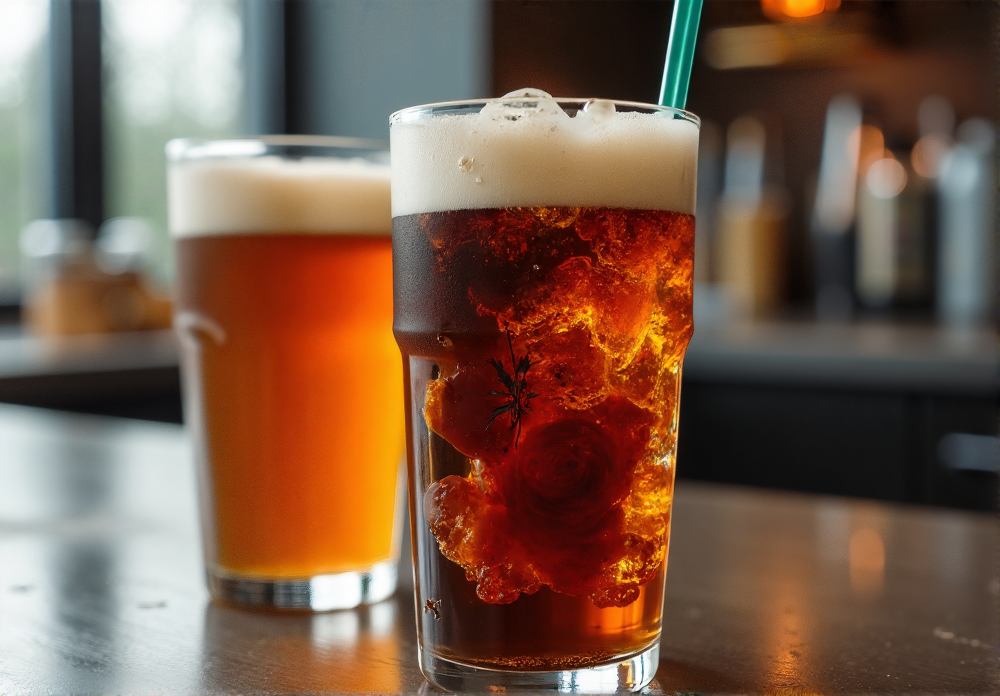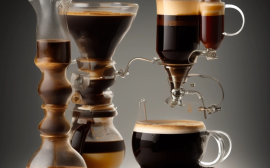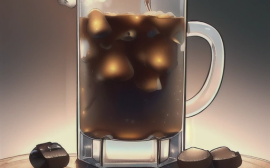Next-Gen Cold Brew: A Deep Dive into Emerging Innovations and Market Trends
The cold brew coffee market is experiencing explosive growth, fueled by a global shift in consumer preferences towards smoother, less acidic, and more flavorful coffee experiences. This surge in popularity isn’t just a fleeting trend; it represents a fundamental change in how consumers perceive and consume coffee, driven by a desire for premium quality, convenience, and innovative brewing methods. This article delves into the dynamic landscape of next-generation cold brew, exploring the latest innovations that are propelling the market forward, from nitrogen infusion and ready-to-drink (RTD) formats to at-home concentrate systems. We’ll examine emerging product categories, dissect evolving consumer preferences, and analyze competitive pricing strategies within the broader beverage industry context. Join us as we uncover the exciting developments shaping the future of cold brew and its impact on the coffee industry as a whole. The rise of cold brew reflects a broader trend within the food and drink sector: the premiumization of everyday beverages. Consumers are increasingly willing to pay a premium for high-quality ingredients, unique flavor profiles, and convenient formats. This shift is evident in the growth of specialty coffee shops, the proliferation of artisanal coffee brands, and the increasing demand for cold brew in retail settings. Data from market research firms like Mintel and Nielsen confirm this upward trajectory, showing double-digit growth in cold brew sales over the past few years. Experts predict this growth will continue as cold brew expands beyond its initial niche market and becomes a mainstream beverage choice. The appeal of cold brew extends beyond its smoother, less acidic profile. The brewing process itself, which involves steeping coffee grounds in cold water for an extended period, allows for a greater extraction of flavor compounds, resulting in a richer, more nuanced taste. This characteristic has opened up new avenues for flavor innovation, with brands experimenting with unique blends, single-origin beans, and infusions of complementary flavors like vanilla, chocolate, and spices. The versatility of cold brew also lends itself to a variety of consumption occasions, from a refreshing morning pick-me-up to an evening cocktail ingredient. Furthermore, the increasing awareness of health and wellness trends has contributed to cold brew’s popularity. Consumers perceive cold brew as a healthier alternative to traditional iced coffee, often associating it with lower acidity and a smoother digestive experience. This perception, coupled with the growing demand for functional beverages, has led to the emergence of cold brew products infused with ingredients like probiotics, adaptogens, and collagen, further blurring the lines between coffee and wellness drinks. Finally, social media and influencer marketing have played a significant role in shaping consumer perceptions and driving demand for cold brew. Visually appealing content and endorsements from key influencers have helped elevate cold brew’s image and establish it as a trendy and desirable beverage. This digital buzz, combined with innovative product development and strategic marketing campaigns, is positioning cold brew as a key driver of growth within the broader coffee and beverage industry.
Nitrogen Infusion: The Rise of Velvety Smooth Cold Brew
Nitrogen-infused cold brew has revolutionized the cold brew coffee market, introducing a new level of sensory enjoyment to the coffee experience. The process of infusing nitrogen gas creates a cascading visual effect, reminiscent of a creamy Guinness stout, and imbues the cold brew with a rich, velvety texture that elevates the drinking experience. This enhanced texture complements the naturally smooth, low-acidity profile of cold brew, resulting in a sweeter, more palatable flavor that appeals to a broad consumer base, from seasoned coffee aficionados to those new to the world of specialty coffee. Leading brands like Stumptown and La Colombe have capitalized on this trend, positioning nitrogen-infused cold brew as a premium offering that caters to the growing demand for elevated coffee experiences. Their success has fueled market growth and inspired numerous other brands to enter the nitrogen-infused cold brew segment, further solidifying its place as a significant coffee trend. The unique selling proposition lies not only in the enhanced sensory experience but also in the perceived novelty and sophistication associated with this brewing method. This resonates particularly well with younger demographics and those seeking unique and shareable experiences, driving significant engagement on social media platforms and influencing purchasing decisions. The rise of nitrogen-infused cold brew taps into the broader consumer trend of premiumization within the beverage industry. Consumers are increasingly willing to pay a premium for products that offer superior quality, unique sensory experiences, and a touch of indulgence. This willingness to spend more reflects a shift in consumer preferences towards quality over quantity, driving growth in the premium coffee segment. Nitrogen infusion aligns with this trend by offering a luxurious and elevated coffee experience that justifies a higher price point. From a food and drink perspective, nitrogen-infused cold brew has opened up new avenues for flavor innovation and pairings. The creamy texture lends itself well to experimentation with complementary flavors, such as vanilla, chocolate, and caramel. This versatility allows cafes and coffee shops to create signature drinks that cater to evolving consumer palates and drive sales. The trend also intersects with the growing consumer interest in healthier beverage options. Cold brew, by nature, is less acidic than traditionally brewed hot coffee, making it a gentler option for those with sensitive stomachs. The addition of nitrogen further enhances this smoothness, attracting health-conscious consumers seeking both flavor and digestive comfort. The continued innovation in this segment, including the development of at-home nitrogen infusion systems, further democratizes access to this premium coffee experience and positions it for long-term growth within the broader coffee market.
Ready-to-Drink: Convenience and Innovation on the Go
The Ready-to-Drink (RTD) cold brew market segment is experiencing explosive growth, fueled by the increasing demand for convenient, high-quality coffee on the go. This aligns perfectly with evolving consumer lifestyles that prioritize efficiency and portability, transforming how consumers enjoy their daily caffeine fix. Innovative packaging plays a crucial role in this segment, with single-serve cans and resealable bottles catering to busy schedules and on-the-go consumption. The success of brands like Califia Farms and SToK underscores this shift, effectively capturing the attention of consumers seeking premium coffee experiences without sacrificing convenience. These brands have strategically positioned themselves at the forefront of this trend, driving traditional coffee consumption towards convenient, ready-made options.
The rise of RTD cold brew also reflects broader trends within the beverage industry. Consumers are increasingly seeking premium, ready-to-consume beverages, and cold brew aligns perfectly with this demand. The category’s emphasis on quality ingredients, specialized brewing methods, and unique flavor profiles resonates with a discerning consumer base. This premiumization trend opens up opportunities for brands to innovate with flavor profiles, functional ingredients, and sustainable packaging. For example, some brands are incorporating adaptogens like Lion’s Mane mushroom or offering organic and fair-trade certified options to appeal to health-conscious and ethically-minded consumers.
Furthermore, the RTD format allows for greater experimentation with flavor combinations that might be less practical for at-home brewing. This allows brands to cater to diverse palates and offer innovative flavor profiles, such as vanilla, mocha, or even seasonal blends like pumpkin spice. Such flavor innovation keeps the category exciting and attracts new consumer segments, further propelling market growth. The single-serve nature of RTD cold brew also simplifies portion control and reduces waste, appealing to environmentally conscious consumers and aligning with broader sustainability trends within the food and drink industry. This convenience factor, coupled with the expanding variety of flavor options, solidifies RTD cold brew as a significant force in the evolving coffee landscape.
The competitive landscape of the RTD cold brew market is dynamic, with both established coffee brands and emerging players vying for market share. Pricing strategies vary widely, reflecting different brand positioning and target demographics. While some brands compete on price, others focus on premium ingredients and unique brewing processes to justify higher price points. This market segmentation allows consumers to choose products that align with their budget and desired level of quality. Understanding these consumer preferences and market trends is essential for brands looking to succeed in this increasingly competitive segment. Effective marketing and distribution strategies are also crucial for reaching target audiences and establishing brand loyalty. This includes leveraging social media, influencer partnerships, and targeted advertising campaigns to raise brand awareness and drive sales.
Finally, the portability and convenience of RTD cold brew have made it a popular choice for various consumption occasions, from busy mornings and afternoon pick-me-ups to social gatherings and outdoor activities. This versatility further expands the product’s appeal and contributes to its sustained market growth. As consumer demand for convenient, high-quality coffee continues to rise, the RTD cold brew segment is poised for continued expansion and innovation. This dynamic category offers exciting opportunities for brands to connect with consumers and shape the future of coffee consumption.
Cold Brew Concentrates: Mastering the Art of At-Home Brewing
Cold brew concentrate systems represent a significant evolution in at-home coffee preparation, empowering enthusiasts to replicate their favorite coffee shop experiences within the comfort of their own kitchens. These systems, ranging from simple immersion setups to more sophisticated automated devices, cater to a wide spectrum of user needs and preferences. Manual options often involve a straightforward steeping process using a specialized container and filter, allowing for a hands-on approach where users can adjust parameters like steeping time and coffee-to-water ratio to achieve their ideal flavor profile. Automated systems, on the other hand, incorporate features like timed cycles and temperature control, offering a more consistent and hands-off approach for those seeking convenience. The increasing popularity of these systems highlights a broader consumer trend towards personalized food and beverage experiences. The cost-effectiveness of cold brew concentrates is a major draw, as a single bottle can yield multiple servings, making it a more economical option compared to frequent coffee shop visits or ready-to-drink options. This appeals particularly to budget-conscious consumers who still want to enjoy high-quality coffee at home. Furthermore, the ability to control the strength and flavor of the final beverage is a key advantage, allowing users to customize their cold brew to their individual tastes, whether they prefer a bold, intense brew or a lighter, more subtle flavor. The variety of concentrates available on the market is vast, ranging from classic dark roasts to more adventurous single-origin options. This allows consumers to explore a wide array of flavor profiles and find their perfect coffee match. This trend also aligns with the broader beverage industry’s focus on offering diverse and customizable products to meet varied consumer preferences. The market for cold brew concentrates has also seen the rise of innovative packaging and dispensing solutions, such as bag-in-box systems and easy-pour bottles, further enhancing the user experience. Brands are also increasingly focusing on sustainable sourcing and packaging practices, aligning with the growing consumer demand for environmentally responsible products. As the cold brew market continues to expand, we can expect further innovations in concentrate systems, catering to the ever-evolving needs and preferences of coffee lovers. This is part of the overall movement in the coffee industry towards more convenient, customizable and cost-effective at-home brewing solutions, a trend that is likely to further solidify cold brew’s position in the market.
Market Trends and Consumer Preferences: Shaping the Future of Cold Brew
The cold brew market is undergoing a dynamic transformation, fueled by evolving consumer preferences and innovative production techniques. Trends like sustainability and premiumization are significantly impacting consumer choices, driving demand for higher quality, ethically sourced, and environmentally conscious cold brew products. Consumers are not just seeking a caffeine fix; they’re looking for a complete sensory experience, from the rich aroma to the smooth, low-acid taste. This shift in consumer behavior is pushing brands to innovate across the entire value chain, from sourcing beans to packaging and distribution. For example, companies like Wandering Bear are leading the charge with their focus on organic, fair-trade coffee and eco-friendly packaging, appealing to the environmentally conscious consumer. This commitment to sustainability resonates with a growing segment of coffee drinkers who prioritize ethical sourcing and minimal environmental impact. The demand for premiumization is evident in the rise of specialty cold brew offerings, often featuring unique flavor profiles and high-quality ingredients. Brands are experimenting with single-origin beans, small-batch roasting, and innovative brewing methods to create distinctive and sophisticated cold brew experiences. This pursuit of excellence allows brands to command premium prices, reflecting the perceived value and enhanced quality of their products. Consumers are increasingly interested in functional ingredients and unique flavor profiles, further propelling innovation within the cold brew sector. The addition of adaptogens, such as Lion’s Mane mushroom and Ashwagandha, caters to the health-conscious consumer seeking beverages that offer potential cognitive and stress-relieving benefits. Similarly, the incorporation of unique flavor combinations, like vanilla bean, coconut, and even spices like cardamom, expands the cold brew experience beyond traditional offerings, attracting adventurous palates. This experimentation with flavors and functional ingredients allows brands to differentiate themselves in a competitive market and cater to specific consumer needs and preferences. Social media and influencer marketing play a pivotal role in shaping consumer perceptions and driving demand within the cold brew market. Platforms like Instagram and TikTok provide a visual medium for showcasing aesthetically pleasing cold brew creations and highlighting the unique characteristics of different brands. Influencers, with their established credibility and engaged followings, can effectively communicate the value proposition of specific cold brew products and influence purchasing decisions. This digital engagement creates a buzz around new product launches and fosters a sense of community among cold brew enthusiasts, ultimately driving market growth and shaping consumer trends. The rise of online coffee communities further amplifies this effect, providing platforms for consumers to share their experiences, discover new brands, and engage in discussions about the latest cold brew innovations. Premium pricing strategies are not only viable but often expected within the evolving cold brew landscape. Consumers are willing to pay a premium for cold brew that delivers on quality, taste, and ethical sourcing. This willingness to invest in a premium product reflects the perceived value of cold brew as a sophisticated and enjoyable beverage, distinct from traditional iced coffee. The premium positioning of cold brew is further reinforced by its association with specialty cafes and artisanal coffee shops, where the focus on quality and craftsmanship justifies higher price points. As the cold brew market continues to evolve, brands that prioritize quality, innovation, and sustainability will be best positioned to capture the attention and loyalty of discerning consumers.



